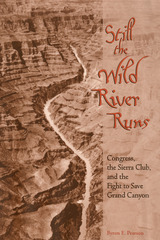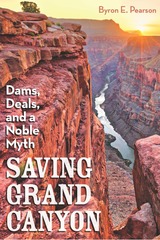2 books by Pearson, Byron E

Byron E. Pearson
University of Arizona Press, 2002
Between 1963 and 1968, environmentalists were outraged when western water interests sought to construct two dams in Grand Canyon as part of the Central Arizona Project. The Sierra Club led a national campaign opposed to the project, which most environmental historians credit with defeating the dams. In the wake of its victory, the Sierra Club has been lauded as the savior of Grand Canyon. Byron Pearson now takes a closer look at history to show that the Sierra Club's ability to mobilize public opinion did not appreciably influence Congress, where the issue was actually decided. When Arizona congressman Stewart Udall became Interior Secretary in 1960, he promoted a plan to import water from the Pacific Northwest to California in order to placate that state's opposition to the CAP with its proposed dams. When this support dissolved in the face of resistance from Washington senator Henry Jackson, who chaired the Senate Interior Committee, the pragmatic Udall sought passage of a bare-bones CAP bill without the dams before he and Arizona senator Carl Hayden retired. Despite this congressional deal-making, the Sierra Club received credit for blocking the dams and was propelled to the undisputed leadership of the environmental movement. Using the myth that it had saved the Canyon, the club transformed its image of power into real political influence after Congress passed the National Environmental Policy Act in 1970, giving environmental advocates access to the policy-making process for the first time. In revealing how the Sierra Club played a much lesser role in blocking the dams than they would have had the public believe, Pearson contrasts the ways in which the controversy unfolded in the court of public opinion versus the actual political process. He takes readers into congressional chambers and conference rooms, reconstructing the legislative process to convey the full flavor of this political give-and-take. Based on research in archives from all over the country, Still the Wild River Runs will itself be a subject of controversy as it challenges long-standing notions about the power of environmental lobbies. By putting this chain of historical events in clearer perspective, it can give citizens concerned with future causes a better understanding of the political process and what really moves it.
[more]

Saving Grand Canyon
Dams, Deals, and a Noble Myth
Byron E. Pearson
University of Nevada Press, 2019
2020 Winner of the Southwest Book Awards
2020 Spur Awards Finalist Contemporary Nonfiction, Western Writers of America
The Grand Canyon has been saved from dams three times in the last century. Unthinkable as it may seem today, many people promoted damming the Colorado River in the canyon during the early twentieth century as the most feasible solution to the water and power needs of the Pacific Southwest. These efforts reached their climax during the 1960s when the federal government tried to build two massive hydroelectric dams in the Grand Canyon. Although not located within the Grand Canyon National Park or Monument, they would have flooded lengthy, unprotected reaches of the canyon and along thirteen miles of the park boundary.
Saving Grand Canyon tells the remarkable true story of the attempts to build dams in one of America’s most spectacular natural wonders. Based on twenty-five years of research, this fascinating ride through history chronicles a hundred years of Colorado River water development, demonstrates how the National Environmental Policy Act came to be, and challenges the myth that the Sierra Club saved the Grand Canyon. It also shows how the Sierra Club parlayed public perception as the canyon’s savior into the leadership of the modern environmental movement after the National Environmental Policy Act became law.
The tale of the Sierra Club stopping the dams has become so entrenched—and so embellished—that many historians, popular writers, and filmmakers have ignored the documented historical record. This epic story puts the events from 1963–1968 into the broader context of Colorado River water development and debunks fifty years of Colorado River and Grand Canyon myths.
2020 Spur Awards Finalist Contemporary Nonfiction, Western Writers of America
The Grand Canyon has been saved from dams three times in the last century. Unthinkable as it may seem today, many people promoted damming the Colorado River in the canyon during the early twentieth century as the most feasible solution to the water and power needs of the Pacific Southwest. These efforts reached their climax during the 1960s when the federal government tried to build two massive hydroelectric dams in the Grand Canyon. Although not located within the Grand Canyon National Park or Monument, they would have flooded lengthy, unprotected reaches of the canyon and along thirteen miles of the park boundary.
Saving Grand Canyon tells the remarkable true story of the attempts to build dams in one of America’s most spectacular natural wonders. Based on twenty-five years of research, this fascinating ride through history chronicles a hundred years of Colorado River water development, demonstrates how the National Environmental Policy Act came to be, and challenges the myth that the Sierra Club saved the Grand Canyon. It also shows how the Sierra Club parlayed public perception as the canyon’s savior into the leadership of the modern environmental movement after the National Environmental Policy Act became law.
The tale of the Sierra Club stopping the dams has become so entrenched—and so embellished—that many historians, popular writers, and filmmakers have ignored the documented historical record. This epic story puts the events from 1963–1968 into the broader context of Colorado River water development and debunks fifty years of Colorado River and Grand Canyon myths.
[more]
READERS
Browse our collection.
PUBLISHERS
See BiblioVault's publisher services.
STUDENT SERVICES
Files for college accessibility offices.
UChicago Accessibility Resources
home | accessibility | search | about | contact us
BiblioVault ® 2001 - 2024
The University of Chicago Press









